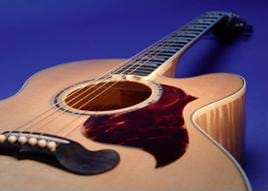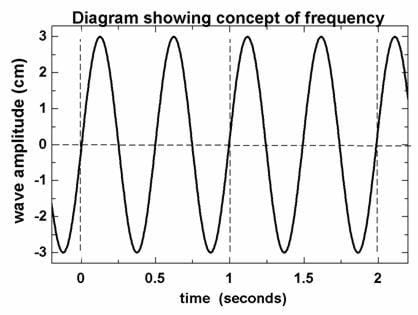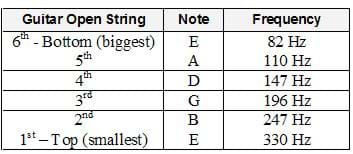Quick Look
Grade Level: 4 (3-5)
Time Required: 15 minutes
Lesson Dependency:
Subject Areas: Physical Science
NGSS Performance Expectations:

| 4-PS3-2 |

Summary
Students learn about sound with an introduction to the concept of frequency and how it applies to musical sounds.Engineering Connection
Frequency is a important to understand for engineering purposes. For example, an engineer might need to know how often something happens or how often something should happen. Engineers use their knowledge of frequencies to design many commonly used items: lights, televisions and even traffic signals, which are specifically programmed to start or stop according to traffic patterns. Frequency is also an important part of music, as notes with different frequencies make different sounds. Acoustic engineers help design auditoriums that enable everyone to hear the music produced on stage.
Learning Objectives
After this lesson, students should be able to:
- Explain frequency.
- Give an example of frequency.
- Explain that different frequencies of sound waves produce different sounds.
Educational Standards
Each TeachEngineering lesson or activity is correlated to one or more K-12 science,
technology, engineering or math (STEM) educational standards.
All 100,000+ K-12 STEM standards covered in TeachEngineering are collected, maintained and packaged by the Achievement Standards Network (ASN),
a project of D2L (www.achievementstandards.org).
In the ASN, standards are hierarchically structured: first by source; e.g., by state; within source by type; e.g., science or mathematics;
within type by subtype, then by grade, etc.
Each TeachEngineering lesson or activity is correlated to one or more K-12 science, technology, engineering or math (STEM) educational standards.
All 100,000+ K-12 STEM standards covered in TeachEngineering are collected, maintained and packaged by the Achievement Standards Network (ASN), a project of D2L (www.achievementstandards.org).
In the ASN, standards are hierarchically structured: first by source; e.g., by state; within source by type; e.g., science or mathematics; within type by subtype, then by grade, etc.
NGSS: Next Generation Science Standards - Science
| NGSS Performance Expectation | ||
|---|---|---|
|
4-PS3-2. Make observations to provide evidence that energy can be transferred from place to place by sound, light, heat, and electric currents. (Grade 4) Do you agree with this alignment? |
||
| Click to view other curriculum aligned to this Performance Expectation | ||
| This lesson focuses on the following Three Dimensional Learning aspects of NGSS: | ||
| Science & Engineering Practices | Disciplinary Core Ideas | Crosscutting Concepts |
| Make observations to produce data to serve as the basis for evidence for an explanation of a phenomenon or test a design solution. Alignment agreement: | Energy can be moved from place to place by moving objects or through sound, light, or electric currents. Alignment agreement: Energy is present whenever there are moving objects, sound, light, or heat. When objects collide, energy can be transferred from one object to another, thereby changing their motion. In such collisions, some energy is typically also transferred to the surrounding air; as a result, the air gets heated and sound is produced.Alignment agreement: | Energy can be transferred in various ways and between objects. Alignment agreement: |
International Technology and Engineering Educators Association - Technology
-
Explain how various relationships can exist between technology and engineering and other content areas.
(Grades
3 -
5)
More Details
Do you agree with this alignment?
State Standards
Colorado - Science
-
Energy comes in many forms such as light, heat, sound, magnetic, chemical, and electrical
(Grade
4)
More Details
Do you agree with this alignment?
Pre-Req Knowledge
Definitions of longitudinal and transverse waves (Lesson 1) and wavelength and amplitude (Lesson 2).
Introduction/Motivation
Deciding to play it smart and safe, Angie and Harmon listen to the tsunami warning and, with their parents, move to the center of the island to wait out the warning. Soon Angie and Harmon are bored. They wish they could listen to some music, but there is no stereo or musical instrument in their sheltered area. All they can find are some glasses, bottles, rubber bands and old boxes. With your engineering know-how and knowledge of waves, do you think that you can help them figure out how to make some music?
You have already learned about waves. However, one last concept is very important for you to learn —frequency — which will help you make music! The frequency of something is how many times it occurs in a given time period. Did you all eat breakfast this morning? How many times do we eat breakfast in one day? (Answer: Once) So, the frequency of breakfast is one time per day. Let's try another example: Who rode the bus this morning? What is the frequency of riding the bus for school purposes? (Answer: twice per day: one time to school and one time from school) How about summertime? What do you think is the frequency of summer? (Answer: once per year)
The frequency is how often something occurs in a given period of time. Waves can also be measured using frequency. For waves, frequency is the number of wave crests (or the highest part of the wave) that occur at one place in a given time period. If 60 waves crash on the beach in 6 minutes, then the frequency of waves crashing is 10 waves per minute. Or, if only one wave crashed on the beach in one hour, then what would the frequency be? That's right, one wave per hour. Ask the students if 20 waves crash in 4 minutes, what is the frequency? (Answer: 5 waves per minute)
Now I want you to turn to the person next to you and see if you can work together to come up with your very own example of frequency. It could be something from your own experiences, such as how often you feed your hamster, pet your dog or even brush your teeth. When you are done, we will take turns sharing our examples.
Now, it's time to talk about music. How do you think music and frequency are connected? Well it's very simple actually: when sound travels at different frequencies, it creates different noises. If the sound waves are traveling very fast, would that be a high or low frequency? That's right: high. How about if they were going really slow? Right, that would be a low frequency. If a sound is traveling really fast, it sounds very high pitched to our ears; if it's traveling real slowly, it sounds low to our ears. Let's say that together: "Fast is high, slow is low!" Our ears can only hear certain frequencies, but different animals can hear different ranges of frequencies. Dogs can hear sounds of much higher frequencies than we can — perhaps that is why they bark at times when we do not understand what they are barking at or why they are barking.
When talking about frequency, we talk about per-month, per-day and per-minute frequencies, but when engineers, scientists and musicians measure frequency, they talk about "per-second." Who can tell me what per-second means? Right! The number of times something happens (in this case, the number of sound waves) per second. The special name for per-second is hertz, and it is written as Hz (write it on the board).
So, if a sound has a big Hz, that means that it has a high frequency. What would it sound like? (Answer: high-pitched) Great! And if it has a small Hz, that means it has a slow frequency. What would that sound be? (Answer: low-pitched) Musicians need to know about frequencies when they play their instruments, and the crafters who design and create instruments need to understand frequencies so that the musicians who use their devices deliver the anticipated sound! There is a special kind of engineer, called an acoustical engineer, who helps design auditoriums so that everyone in the audience can hear the beautiful music played on stage. Do you think acoustical engineers need to know about frequencies of musical notes? They sure do!
Now you are going to create some of your very own instruments in the associated activity Simple Instruments. While you design them, think about the sounds you want them to produce and what type of frequencies that involves!
Lesson Background and Concepts for Teachers
Frequency means the number of times something occurs within a given time period. Frequency for waves is usually measured per second. The unit for frequency is Hertz (Hz), which means per second. So, a wave frequency of one Hz means that one wave occurs per second.
The amplitude of the wave in the Figure 1 is 3 cm. What is the wavelength? (Answer: We cannot actually tell, because the x-axis is time, not distance.) What is this wave's frequency? (Answer: Two crests appear per second, so the frequency is 2 waves per second, or 2 Hz.)

Our ears can hear sound waves caused by vibrations between 20 Hz and 20,000 Hz. Twenty Hz sounds very, very low — such as the sounds from a foghorn or a tuba. Sounds of 20,000 Hz are very high, such as from a whistle or fingernails scraping on a chalkboard. Ultrasonic waves (waves with extremely high frequencies, outside of our range of hearing) are used in medical and industrial applications.
Sound waves have characteristics that allow us to distinguish one sound from another. These characteristics include: location, loudness, pitch, register, duration, rate of change, order, attack/decay and timbre.
The more energy a sound wave has the louder the sound seems. The intensity of a sound is the amount of energy it has. We hear intensity as loudness. Or, loudness is how strong the sound seems when it reaches our ears. The amplitude (or height) of a sound wave is a measure of the amount of energy in the wave. See Figure 2 for illustration. The greater the amplitude of a wave, the greater the intensity of the sound. Intensity is measured in decibel units by sound meters. Sounds above 120 decibels are painful to the ears and can cause injury to the ear if prolonged.

Pitch refers to how high or low a sound seems depending on its frequency. High-pitched sounds are high-frequency; low-pitched sounds are low-frequency. High and low pitch are illustrated in Figure 2.

Timbre is the term referring to tone quality, and it refers to the overall quality of the sound as affected by the other sound characteristics. A pleasant sound has a regular wave pattern. The pattern is repeated over and over. But the waves of noise are irregular. They do not have a repeated pattern (see Figure 4).

Associated Activities
- Simple Instruments - Student pairs make four different instruments: shoebox guitars, water glass xylophones, straw panpipes and soda bottle organs.
Lesson Closure
Great job today, everyone! We talked about the engineering word for how often something happens — frequency. We also learned that sound waves at different frequencies sound differently. Do you remember our little saying, "fast is high, slow is low"?
Instrument makers use their knowledge of frequencies to create instruments that make very specific sounds. Angie and Harmon could use the materials they found in the middle of the island to make instruments while they wait for the tsunami to end.
In our next lesson, we are going to investigate how engineers can use sound waves to see things – even in the dark!
Vocabulary/Definitions
acoustics: A term that refers to the characteristics of an area (such as a sound room, stadium, theater, auditorium, etc.) that determines the users' ability to hear quality sound.
frequency: The number of times something happens in a given time period. It is usually measured in Hertz (Hz), which is the number of waves per second.
Hertz: A unit of frequency, equal to once per second.
Assessment
Pre-Lesson Assessment
Puzzle it Out!: Ask students to think for one minute (watch the clock) about what frequency is. Ask them to think about where they may have heard the word frequency used. If they're stuck, give them time to talk with the person next to them. Ask students to share their ideas with the class.
Post-Introduction Assessment
Clapping Frequencies: Ask for a volunteer to clap at a very slow frequency. Have her/him clap very loud (large amplitude) and very soft (small amplitude). Have someone else try a faster frequency, and then have a third volunteer clap at a very fast frequency. If you like, have the whole class try slow, faster and very fast clapping frequencies all together. Ask students to compare student and class claps.
Post-Lesson Assessment
Frequency Story!: Have the students each write one sentence about frequency in their lives (for example, "I don't floss my teeth with enough frequency, I floss with a frequency of one time per week"). Their sentence should include a numerical value for frequency. Alternatively, have students write one sentence about how frequency is a key part of music.
Energy: Have students make observations to provide evidence that energy can be transferred from place to place by sound.
Lesson Extension Activities
For older or more advanced students, explore the connection between hertz and sound. Take out a guitar (best) or a tuning fork (okay). Either pluck one of the guitar strings or hit the tuning fork to make a note. On a guitar, the open strings create notes at certain frequencies when plucked. The strings, notes and frequencies (rounded to the nearest frequency) are:

The E of the top string is two octaves above the E of the lowest string. The second octave E is 82 Hz * 2 = 164 Hz, and so the third octave E is 164 Hz * 2 ≈ 330 Hz.
When the lowest string of the guitar is plucked, it moves back and forth 82 times per second. Have the students imagine Figure 1 with 82 Hz instead of 2 Hz. That's a lot of waves per second! If the students look closely at the vibrating string of the guitar, they will only see a blur, as our eyes can only make out things clearly at 30 Hz or less.
If you use a tuning fork, its note and vibrating frequency will be marked on its side. For reference, middle C is 262 Hz and the A used for most tuning forks is 440 Hz. Students can watch and touch the tuning fork to experience the rapid vibration.
Subscribe
Get the inside scoop on all things TeachEngineering such as new site features, curriculum updates, video releases, and more by signing up for our newsletter!More Curriculum Like This

Students work with partners to create four different instruments to investigate the frequency of the sounds they make. Teams may choose to make a shoebox guitar, water-glass xylophone, straw panpipe or a soda bottle organ (or all four!).

Filtering is the process of removing or separating the unwanted part of a mixture. In signal processing, filtering is specifically used to remove or extract part of a signal, and this can be accomplished using an analog circuit or a digital device (such as a computer). In this lesson, students learn...

Students are introduced to sound energy concepts and how engineers use sound energy. Through hands-on activities and demonstrations, students examine how we know sound exists by listening to and seeing sound waves
References
Russel, Dan, 1999. Ketterling University Applied Physics, Acoustics and Vibration Animations, accessed February 1, 2007. http://www.acs.psu.edu/drussell/Demos.html
Science Museum of Minnesota, Science of Sound – Activities, "Hands-On Activities," 1999, accessed February 1, 2007. http://www.smm.org/sound/nocss/activity/handson.htm
Copyright
© 2007 by Regents of the University of Colorado.Contributors
Jessica Todd; Brad Dunkin; Luke Simmons; Chris Yakacki; Brian Kay; Frank Burkholder; Abigail Watrous; Janet YowellSupporting Program
Integrated Teaching and Learning Program, College of Engineering, University of Colorado BoulderAcknowledgements
The contents of these digital library curricula were developed by the Integrated Teaching and Learning Program under National Science Foundation GK-12 grant no. 0338326. However, these contents do not necessarily represent the policies of the National Science Foundation, and you should not assume endorsement by the federal government.
Last modified: April 17, 2021








User Comments & Tips